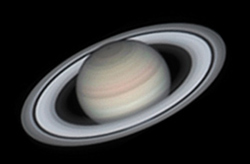
Ask amateur telescope users what's the most beautiful thing in the sky, and lots of them will say Saturn. In fact many say their first sight of it was what turned them on to astronomy. Viewing Saturn in a good telescope often draws gasps from visitors, who after a lifetime of seeing cartoon ringed planets are awed by viewing the original.
But you can never see Saturn as well as you want! The planet is tiny as telescopic targets go; it's barely 21 arcseconds in diameter at its most favorable oppositions. Saturn's ring system is 2.25 times as wide as the ball — but that's still smaller than the width of Jupiter near opposition. And the disk itself shows only about 1/6 the area of Jupiter. Try to magnify it too much and it defies you by turning into a blurry mess. Viewing Saturn is indeed a jewel, exquisite but tiny.
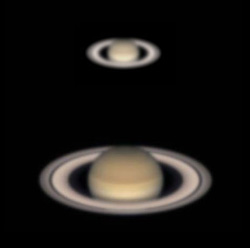
Sky & Telescope illustration; source: NASA / Hubble Space Telescope
However, with time, patience, and a top-quality 4-inch or larger telescope, you can tease out more of the planet's secrets than many observers suspect. But don't expect Hubble-like performance from viewing Saturn with your backyard telescope. The image pair on the right suggest how the ringed planet might look through a small telescope on a mediocre night (top) and through a larger, better telescope on a night when the air is especially still (bottom).
Viewing Saturn's Rings
The rings of Saturn should be visible in even the smallest telescope at 25x. A good 3-inch scope at 50x can show them as a separate structure detached on all sides from the ball of the planet.
Saturn has a more three-dimensional appearance than any other object in the sky — at least that's how it looks to me with a 6-inch scope on a night of fine seeing.
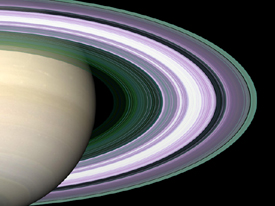
Cassini Radio Science Subsystem Team / JPL / ESA / NASA
The edges of the planet are limb-darkened, making Saturn look like a yellow-brown marble rather than just a disk, while the rings encircling it show no such effect and look as flat as a paper cutout. The planet's shadow on the rings adds to the 3-D appearance once you recognize the direction the sunlight is coming from and how the shadow is being cast.
Details in the rings can be viewed with a small scope during spells of good seeing. The plainest is the black Cassini Division between the A and B rings. Its clarity is an excellent test of atmospheric steadiness and the telescope's optical quality. Shadings within the rings are even easier to discern. The outer A ring is plainly dimmer than the broader B ring inside it. To me, both the A and B rings seem to brighten smoothly to a maximum at the edges of the Cassini Division.The rings' thin shadow on the planet is subtler and visible only some of the time. It shifts from the inside edge to the outside edge of the ring system about every six months from our Earthly viewpoint. Viewing Saturn is prettier when the shadow is on the outside edge; a black line then divides the rings from the ball, improving the 3-D effect.
Explore Saturn and its moons in our free Saturn's Bounty ebook! Enter your email to download the PDF and receive our weekly e-newsletter with the latest news from the world of astronomy.
Belts and Bright Zones
Dark belts and bright zones can often be made out on the ball of the planet. They're much vaguer than the similar belts and zones of Jupiter, but it's rare when my 6-inch reflector shows Saturn completely blank.
Saturn's Moons
And, of course, there are Saturn's many moons. A 2-inch scope will show Titan. A half dozen are sometimes within reach of a 10-inch. Our Saturn Moons mobile app maps out the location of Saturn's nine largest moons at any date and time, and it also contains a wealth of detail about viewing Saturn's bizarre satellite family. If you don't own an Apple device, you can still use our Saturn satellites predictor to create a map of all of Saturn's moons that are visible in amateur telescopes at any date and time.
That's about all viewing Saturn displays to most observers. But there's more...
Saturn's Finer Details
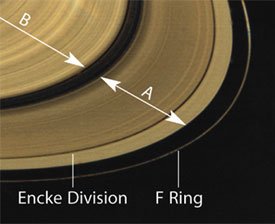
Sky & Telescope illustration; image courtesy NASA/JPL.
In a high-quality planetary telescope of at least 6- or 8-inch aperture on a night of excellent seeing, the rings become more interesting. Near the outer edge of the A ring is the extremely thin Encke Division, an extreme test for any telescope. On a night when the seeing was so steady I could use 450x on my 12.5-inch reflector, I detected the Encke Division for the first time — a complex blur of threadlike details during moments when the air was perfectly steady.
The rings also contain thin, grayish minima in brightness. Julius Benton, the Saturn section coordinator for the Association of Lunar and Planetary Observers (ALPO), claims that as many as 12 are detectable with large telescopes, "of which only about four show any real recurrent visibility from observing night to observing night." Interestingly, Benton claims these brightness minima are known to vary somewhat in both prominence and location.
Ring C, the crepe ring or dusky ring, can be either difficult or easy to make out. Many have seen it without knowing it. Evidence of the C ring is easy to spot when the rings' shadow on the ball appears on their outside. At such times the duskiness you see against the planet just inside the B ring is the semitransparent C.
Changes in the belts and zones become apparent, even obvious, to regular Saturn-watchers — one of the benefits of long-term study. The larger and better your scope the more likely you are to see enough detail to note changes in it.
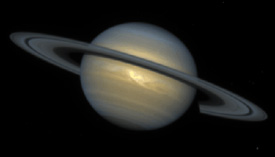
R. Beebe, D. Gilmore & L. Bergeron / STScI / NASA.
Spots and other markings occasionally appear amid the belts and zones. Major white eruptions happen about every 30 years (once per Saturnian year). Lesser bright and dark spots appear more commonly. To predict when a spot will be back at the same location, remember that Saturn's equatorial parts rotate once in about 10 hours 14 minutes. Higher latitudes rotate more slowly, in about 10 hours 38 minutes.
Colors change on Saturn too, but only subtly. The best way to pin them down is to note the relative brightnesses of different areas as seen through red, green, and blue filters. Oddly, the two ends (ansae) of the ring system sometimes appear to differ slightly in color. Using red and blue filters, see if one end looks brighter than the other in either color of light.
Overall, I find that a yellow filter sharpens up the whole planet a trace, probably by suppressing the differences in atmospheric turbulence at the far ends of the spectrum. (Red and blue images quiver and shimmer out of phase with the yellow near the middle of the spectrum. This is the same effect that causes the bright winter star Sirius to twinkle in vivid colors.) A light green filter may slightly improve contrast in the planet's belts and zones.
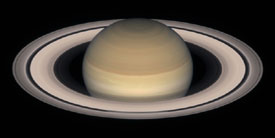
NASA / Hubble Heritage Team
Saturn enthusiasts interested in long-term observing programs can learn more about the ALPO Saturn Section where observation forms are available online.
We've been captivated at the sight of Saturn since Galileo first turned his telescope to the heavens. But it wasn't until the space age that we began to reveal this planet's secrets.
 0
0









Comments
You must be logged in to post a comment.